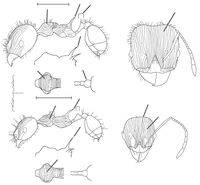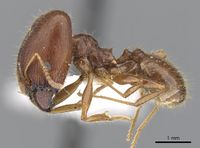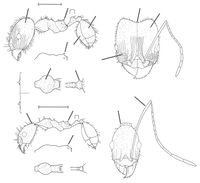Key to Pheidole granulata group
This worker key is based on: Wilson, E. O. 2003. Pheidole in the New World: A dominant, hyperdiverse ant genus. Harvard University Press, Cambridge, MA.
This small assemblage of medium-sized to very large species is strictly western Nearctic in distribution, plus one member, Pheidole hecate, present in Jamaica. Bound together by their 4-Segmented antennal club, versus the 3-segmented state in all other Pheidole, they are heterogeneous in other characters and gathered together here only for taxonomic convenience. (In Pheidole dwyeri the club is 3-segmented in the major, and 4-segmented in the minor.) One species (Pheidole granulata) appears to be a derivative of the fallax group, another (dwyeri) is a good possibility for the same origin, while Pheidole clydei, with a bidentate hypostoma in the major caste, likely originated within the pilifera group. One species known only from the minor caste, Pheidole grundmanni, is problematic, and, finally, the Jamaican endemic hecate, which bears resemblance to Pheidole macromischoides and closely similar species in Cuba, might well have originated from the Neotropical tristis group. The phylogeny will remain unknown until more material can be studied with cladistic and possibly also molecular analysis.
You may also be interested in
1
- Major and minor: propodeal spine as long as the entire petiole; all of the mesosoma covered by prominent carinulae (Jamaica) . . . . . Pheidole hecate
 Pheidole hecate, Major |
- Major and minor (major unknown in grundmanni): propodeal spine at most two-thirds the length of the entire petiole; most of mesosoma devoid of carinulae . . . . . 2
2
return to couplet #1
- A relatively gigantic species, with Head Width of major 2.6 mm and of minor 0.7 mm; head of major also huge relative to mesosoma, its width 2.6 X that of the pronotum; major possesses an ocellus (Tres Marias Islands, Nayarit, Mexico) . . . . . Pheidole dwyeri
 Pheidole dwyeri, Major |
- Smaller species, Head Width of major l.2- l.5 mm and of minor 0.5- 0.6 mm; head of major modest in size relative to mesosoma, its width only about 2 X that of pronotum; major lacks an ocellus (note again: major caste unknown in grundmanni) . . . . . 3
3
return to couplet #2
- Major: scape exceeds occipital border; an extensive area between eye and frontal lobe is rugoreticulate; entire dorsal surface of body, including gaster, is foveolate and opaque. Minor: head strongly narrowed behind, with broad nuchal collar; all of dorsal surface of head and mesosoma foveolate and opaque (Baja California Sur, southern California) . . . . . Pheidole granulata
 Pheidole granulata, Major |
- Major (this caste unknown in grundmanni below): scape reaching only to the midpoint between eye and occipital comer; gaster smooth and shiny. Minor: occiput broad or narrow, but lacks occipital collar. . . . . . 4
4
return to couplet #3
- Minor: in full-face view, occiput narrow, less than two-thirds as broad as clypeus; side of pronotum foveolate and opaque (New Mexico to California) . . . . . Pheidole clydei
 Pheidole clydei, Major |
- Minor: in full-face view, occiput broad, more than three-fourths as wide as clypeus; side of pronotum smooth and shiny (montane Utah) . . . . . Pheidole grundmanni
 Pheidole grundmanni, Minor |










